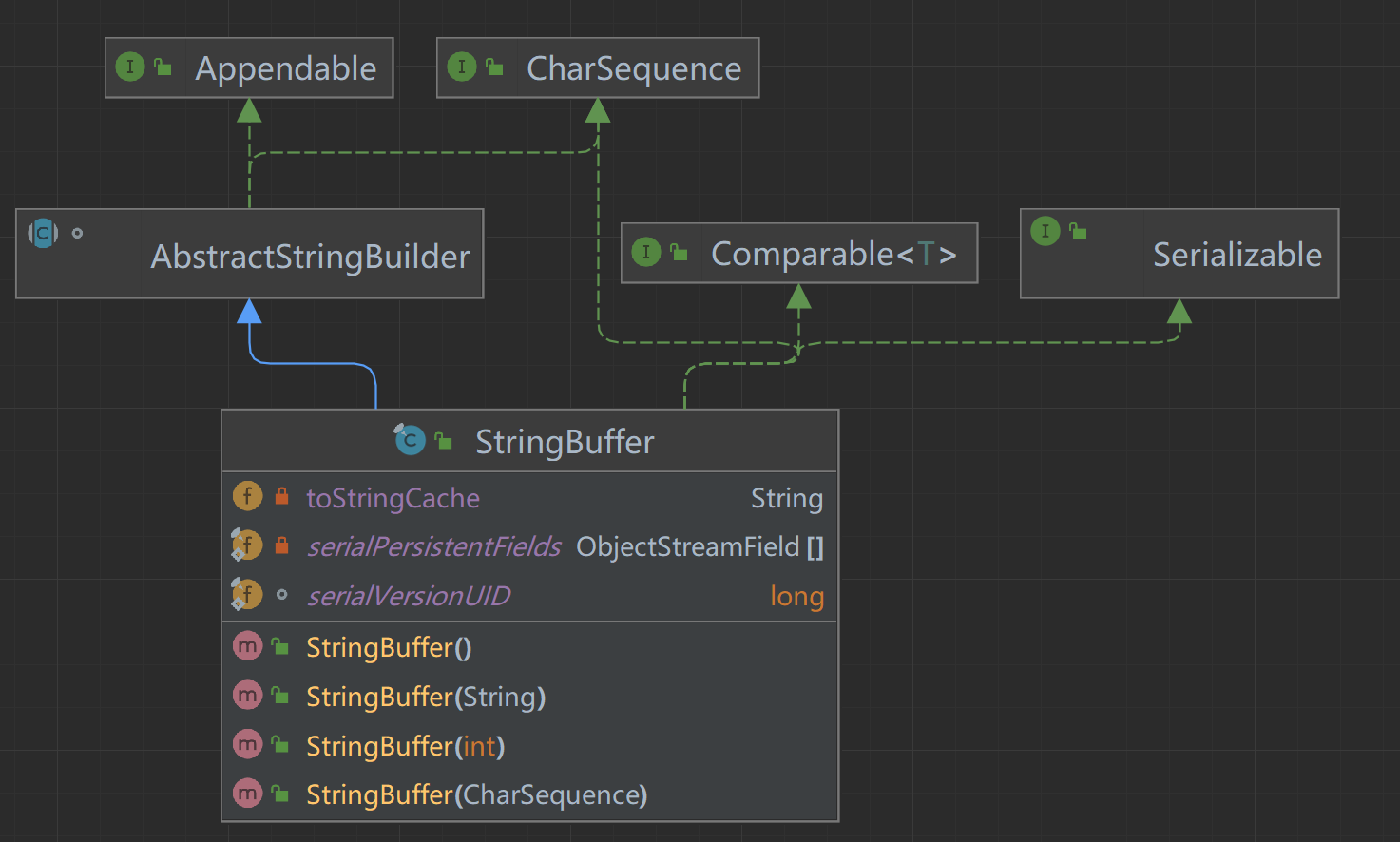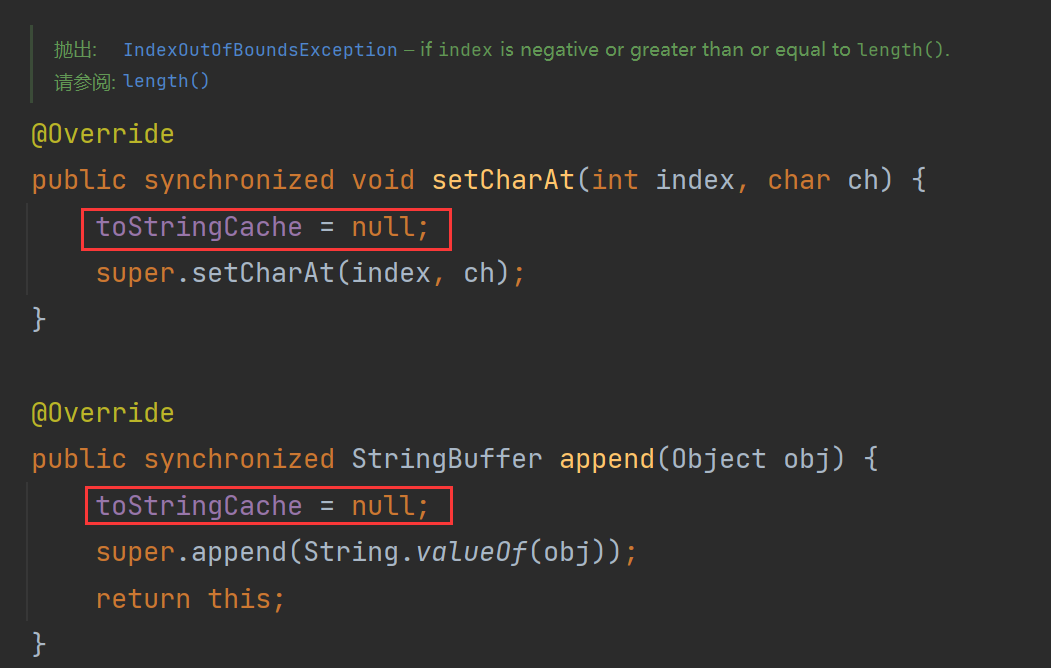StringBuffer类源码剖析
一、StringBuffer类的简介
StringBuffer是线程安全、可变的字符序列。StringBuffer类似于String,但可以被修改。在任何时间点,它都包含一些特定的字符序列,但序列的长度和内容可以通过某些方法调用来更改。StringBuffer可由多个线程安全使用,必要时同步(synchronized)这些方法,以便任何StringBuffer实例上的所有操作都表现得好像它们以某种串行顺序发生,这与所涉及的每个线程进行的方法调用的顺序一致。
注意:每当发生涉及源序列的操作(例如从源序列append或insert)时,此类仅在执行操作的字符串缓冲区上同步,而不在源上同步。请注意,虽然StringBuffer设计为可以安全地从多个线程并发使用,但如果构造函数或追加或插入操作传递了跨线程共享的源序列,则调用代码必须确保操作在操作期间具有一致且不变的源序列视图。这可以通过在操作调用期间保持锁、使用不可变的源序列或不跨线程共享源序列来满足。

二、StringBuffer类的构造方法
StringBuffer类的构造方法与StringBuilder类的构造方法如出一辙,就不过多解释了。

1
2
3
| public StringBuffer() {
super(16);
}
|

1
2
3
| public StringBuffer(int capacity) {
super(capacity);
}
|

1
2
3
4
| public StringBuffer(String str) {
super(str.length() + 16);
append(str);
}
|

1
2
3
4
| public StringBuffer(CharSequence seq) {
this(seq.length() + 16);
append(seq);
}
|
三、StringBuffer类的方法
与构造函数类似,StringBuffer的所有方法基本都是通过调用父类的相应方法实现的,多出的仅仅是 synchrinized修饰符,重点功能实现在于父类AbstractStringBuilder,参考之前的AbstractStringBuilder类源码剖析。不过需要注意一点,StringBuffer类引入了一个新字段toStringCache,顾名思义该字段就是toString方法的缓存,一旦StringBuffer被修改了,该字段也就失效了。
1
2
3
4
5
|
private transient String toStringCache;
|

四、StringBuffer类的toString方法
toString方法会检查上一次调用toString的缓存字段是否失效,如果已经失效则重新创建一个字符串(深拷贝),并且toStringCache字段指向该字符串;否则直接返回toStringCache的一个副本(浅拷贝),不过注意的是String是不可变类,共享String的底层字节数组不存在线程安全问题!。
1
2
3
4
5
6
7
8
| public synchronized String toString() {
if (toStringCache == null) {
return toStringCache =
isLatin1() ? StringLatin1.newString(value, 0, count)
: StringUTF16.newString(value, 0, count);
}
return new String(toStringCache);
}
|
之所以说深拷贝还是浅拷贝是有依据的,前者会拷贝底层的字节数组,后者只是引用的指向!
1
2
3
4
5
6
7
8
9
10
11
12
13
14
15
16
17
18
19
20
21
22
23
24
25
|
public static String newString(byte[] val, int index, int len) {
return new String(Arrays.copyOfRange(val, index, index + len),
LATIN1);
}
public static byte[] copyOfRange(byte[] original, int from, int to) {
int newLength = to - from;
if (newLength < 0)
throw new IllegalArgumentException(from + " > " + to);
byte[] copy = new byte[newLength];
System.arraycopy(original, from, copy, 0,
Math.min(original.length - from, newLength));
return copy;
}
public static native void arraycopy(Object src, int srcPos,
Object dest, int destPos,
int length);
public String(String original) {
this.value = original.value;
this.coder = original.coder;
this.hash = original.hash;
}
|
五、StringBuffer类的序列化/反序列化
1
2
3
4
5
6
7
8
9
10
11
12
13
14
15
16
17
18
19
20
21
22
| private synchronized void writeObject(java.io.ObjectOutputStream s)
throws java.io.IOException {
java.io.ObjectOutputStream.PutField fields = s.putFields();
char[] val = new char[capacity()];
if (isLatin1()) {
StringLatin1.getChars(value, 0, count, val, 0);
} else {
StringUTF16.getChars(value, 0, count, val, 0);
}
fields.put("value", val);
fields.put("count", count);
fields.put("shared", false);
s.writeFields();
}
private void readObject(java.io.ObjectInputStream s)
throws java.io.IOException, ClassNotFoundException {
java.io.ObjectInputStream.GetField fields = s.readFields();
char[] val = (char[])fields.get("value", null);
initBytes(val, 0, val.length);
count = fields.get("count", 0);
}
|





